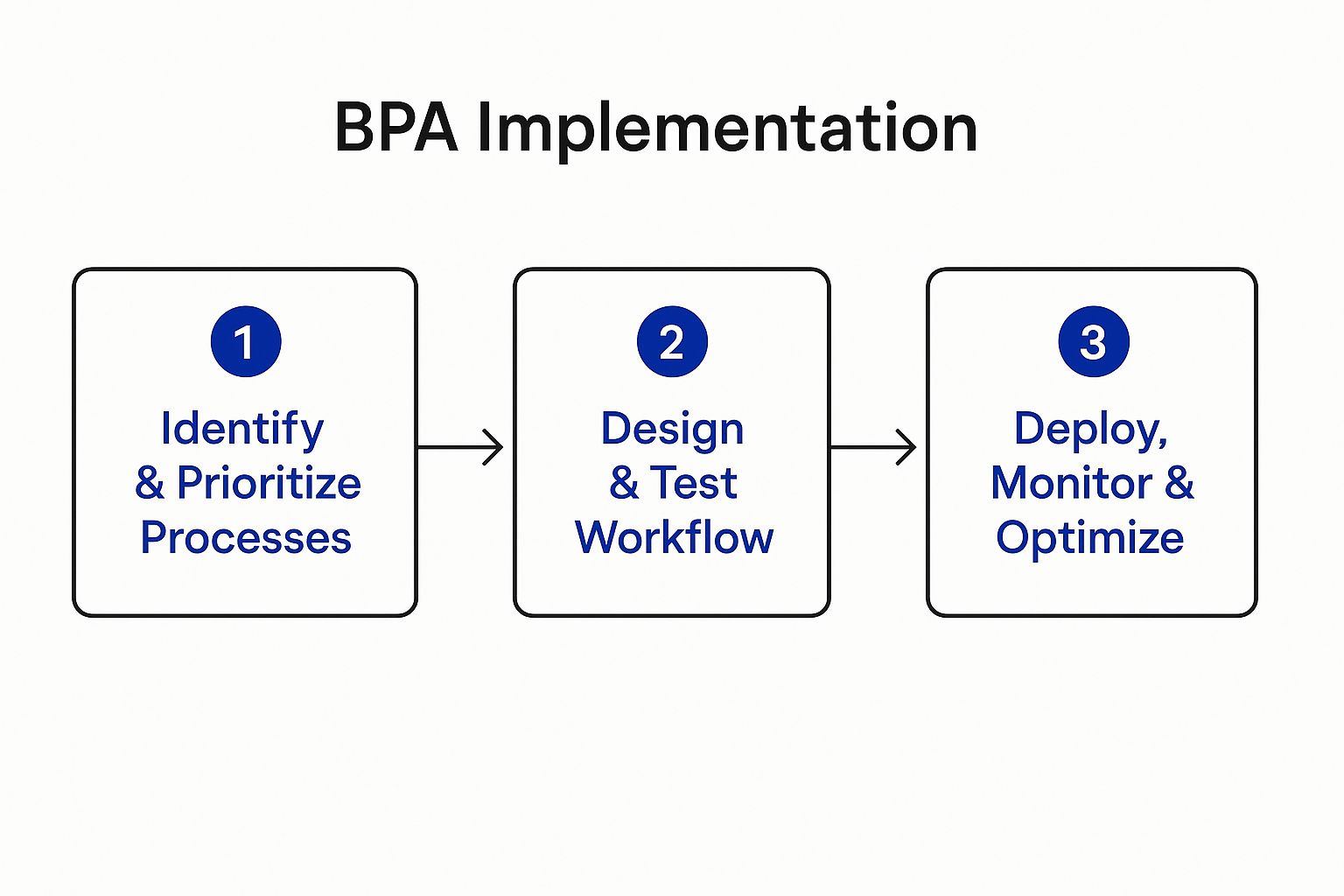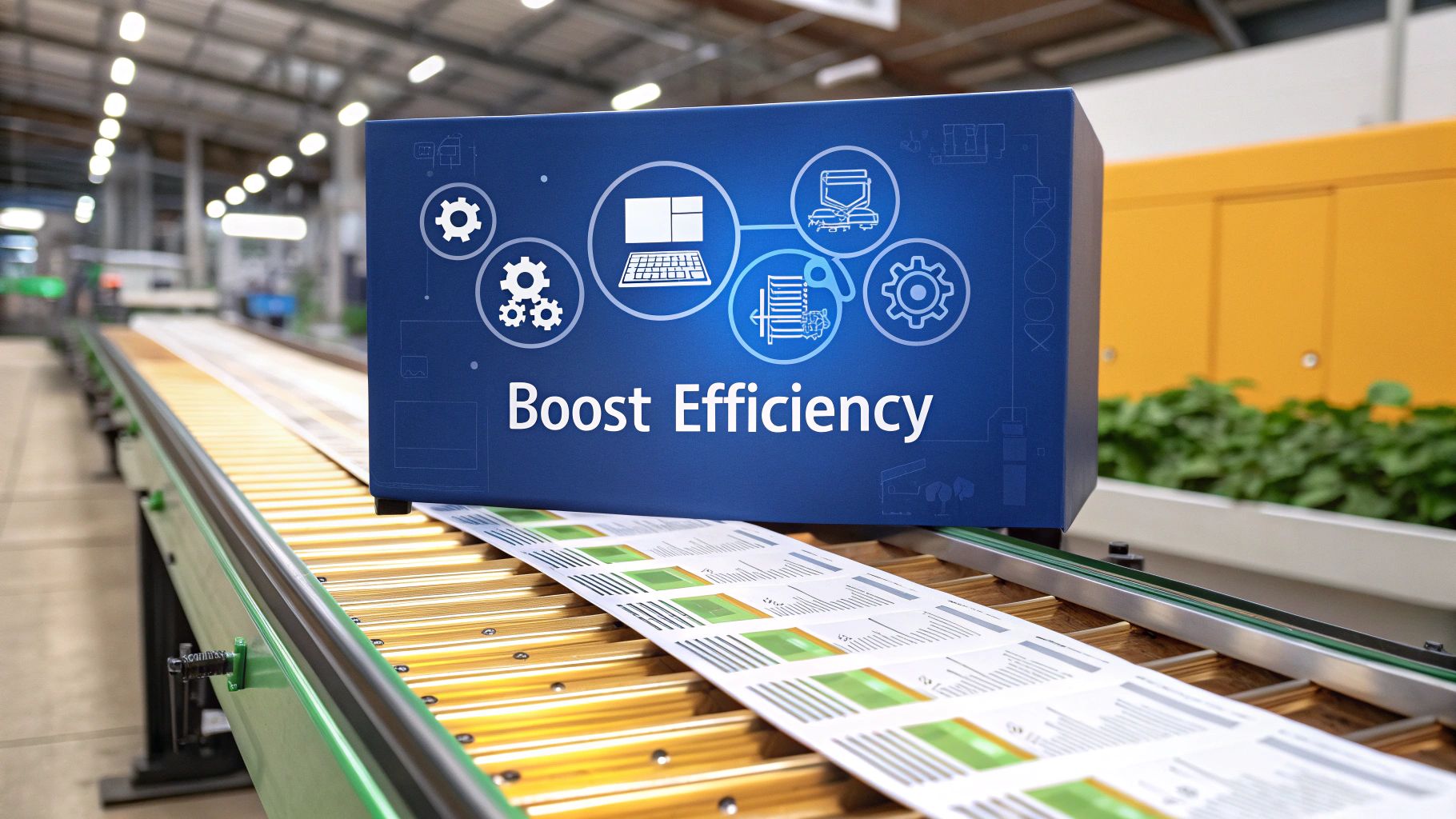Business Process Automation (BPA) is all about using technology to run your recurring business tasks and workflows on autopilot. It’s about taking the repetitive, rule-based jobs that eat up your team’s time, think data entry, invoice processing, or generating reports, and letting software handle them perfectly, every single time.
Decoding Business Process Automation

Imagine your business is a busy restaurant kitchen. Without a solid system, chefs are bumping into each other, ingredients get lost, and orders get mixed up. Business process automation is like the master organizer, making sure every single step happens in the right order, at the right moment.
This isn’t about replacing your talented people. It's about freeing them up. When software takes over the mundane stuff, your team can finally focus on the work that demands real human brainpower.
What BPA Aims to Achieve
The whole point is to stop relying on manual effort for predictable work. Instead of an employee burning hours copying data from a spreadsheet into your CRM, an automated workflow can do it in a blink. This simple change leads to some major improvements:
-
Increased Efficiency: Tasks get done way faster and without anyone needing to oversee them, which means your team can handle a much larger workload.
-
Reduced Human Error: Automation sticks to the script. It eliminates typos, missed steps, and other common slip-ups that can cause headaches and expensive do-overs.
-
Improved Focus: By automating the monotonous, you empower your people to focus on strategic planning, creative problem-solving, and building genuine customer relationships.
Business process automation is really about building a more reliable, efficient, and intelligent operational backbone for your company. It turns chaotic manual processes into streamlined, predictable outcomes.
This shift toward automation is picking up steam across Canadian industries. As of the second quarter of 2025, nearly a quarter (23.1%) of businesses reported using marketing automation, a big jump from 15.2% the previous year. What's more, the use of AI to deliver services has doubled, with 12.2% of businesses now on board. You can dive deeper into these numbers by checking out the official Statistics Canada report.
The Real-World Benefits Of Adopting Automation

So, let's get past the theory. What does bringing automation into your business actually do for your team and your bottom line? The results are tangible and can genuinely reshape how you operate, compete, and grow. It’s all about building a stronger, more efficient core for your business.
One of the first things you'll notice is a serious drop in operational costs. When you automate those repetitive, time-sucking tasks, you drastically cut down the hours your team spends on manual work. This isn't just about saving on payroll; it frees up your budget to pour back into areas that will actually grow the business.
Boosting Accuracy and Compliance
We’ve all seen it happen. Manual data entry, invoice processing, and report building are breeding grounds for human error. A single misplaced decimal or typo can cascade into incorrect orders, delayed payments, or skewed business insights. Automation, on the other hand, follows the rules you set with 100% accuracy, wiping out those costly mistakes.
This precision brings another huge win: better compliance. Many industries have to navigate a maze of strict regulations for handling data and reporting. Automated systems ensure every step is followed to the letter and meticulously documented. This creates a solid audit trail and significantly lowers the risk of facing hefty fines for non-compliance.
Think of automation as your built-in quality control manager. It guarantees that every process runs exactly as it should, every single time. That kind of consistency builds incredible trust with both clients and stakeholders.
Standardizing your processes means everything from onboarding a new customer to approving an expense is done the same way, every time. This is the secret to delivering a reliable, high-quality experience that customers can count on.
Empowering Your Team and Enhancing Agility
Here’s a benefit that often gets overlooked: the massive boost to employee morale. Let’s be honest, nobody gets excited about spending their day on mind-numbing, repetitive tasks. When you hand that drudgery over to automation, your team is freed up to focus on the work that requires real brainpower, like strategy, creativity, and problem-solving.
This shift creates a ripple effect of positive changes:
-
Higher Job Satisfaction: People feel more valued when their talents are put to good use, not wasted on copy-pasting.
-
More Innovation: With the mental clutter cleared away, your team has the space to think up new ideas and find better ways of doing things.
-
Reduced Employee Turnover: An engaged, empowered team is a loyal one. That means less time and money spent on the expensive cycle of hiring and training.
All this efficiency makes your business much more agile. When the market zigs or a new opportunity pops up, an automated company can zag right along with it. You can scale your operations up or down without needing to proportionally increase manual effort, making you far more responsive and competitive. You can see a great practical example of how automation benefits your inventory counting systems by delivering the real-time data needed for quick, smart decisions.
Finding Your Best Automation Opportunities

Knowing where to even begin with business process automation can feel overwhelming. The secret isn't to boil the ocean; it's to look for the low-hanging fruit. I always tell people to hunt for the "three Rs": tasks that are repetitive, rule-based, and routine.
These are the predictable, monotonous jobs that tie up your team's valuable time. Think data entry, report generation, or basic customer follow-ups. They're the perfect candidates to hand over to a system that never gets bored or makes typos.
Instead of a massive, company-wide overhaul, start with small, high-impact wins. This builds momentum and shows everyone the real-world value of automation right away. You'll often find these opportunities hiding in plain sight within the daily grind.
High-Impact Areas to Automate
So, where do you start looking? Think about the workflows that cause the most headaches. Where do things constantly get stuck? Where do simple human errors force your team to do work all over again? These pain points are basically signposts pointing directly to your first automation projects.
Here are a few of the most common and effective places to get started:
-
Finance and Accounting: Imagine an accounts payable process where software automatically receives invoices, matches them to purchase orders, and routes them for approval without a single person having to touch them. That’s a classic, high-value win.
-
Human Resources: Onboarding a new hire involves so many small, repeatable steps. You can automate sending welcome emails, assigning training, and even setting up their software access.
-
Marketing and Sales: Instead of manually blasting email lists, you can set up sequences that automatically nurture leads based on their behaviour, sending the perfect message at just the right time.
By focusing on these common areas first, you can fix major operational bottlenecks and give your teams their time back to focus on work that actually drives the business forward.
This isn't just a strategy for big corporations, either. Small businesses across Canada are catching on. In fact, by 2025, it's expected that 47% of Canadian SMEs will use AI for routine tasks, and 52% will have virtual assistants handling administrative work. This shift shows just how important automation has become for staying efficient and keeping customers happy. You can dive deeper into these AI trends for Canadian businesses on Canadiansme.ca.
Transforming Manual Workflows
To really grasp the power of business process automation, it helps to see the "before and after." A simple change can completely reshape a department's day-to-day, turning a manual slog into a smooth, efficient system.
Let's look at how a few common tasks change once you remove the manual labour.
Manual vs Automated Business Processes
Here’s a quick comparison of what these workflows look like before and after implementing automation.
|
Business Area |
Manual Process Example |
Automated Process Example |
|---|---|---|
|
Finance |
An employee manually keys in invoice data, prints a copy for a manager to sign, and then re-enters it into the payment system. |
Software extracts data from invoices automatically, matches it with purchase orders, and sends an alert to a manager for one-click approval. |
|
Human Resources |
HR staff manually email offer letters, chase down signed documents, and individually set up new hires in multiple company systems. |
An automated workflow sends all onboarding documents, tracks their completion, and creates user accounts across all required systems at once. |
|
Marketing |
A team member manually segments email lists based on recent purchases and sends out generic follow-up messages once a week. |
A system automatically adds new customers to a personalized email sequence, triggering messages based on their specific purchase history and actions. |
Seeing these opportunities is the first real step toward building a more productive and resilient organization.
Choosing the Right Type of BPA Tools
Diving into the world of business process automation software can feel a bit overwhelming, but it really just comes down to matching the right tool to the right job. Think of it like a toolbox: you wouldn't use a sledgehammer to hang a picture frame. The best automation solution always depends on what you're trying to accomplish.
For a lot of businesses, the first step is a simple workflow automation platform. These are the versatile screwdrivers in your toolbox. They're fantastic for handling basic, linear tasks like getting a document approved, processing a new client intake form, or managing a content publishing schedule. If your process follows a clear "if this, then that" logic, a workflow tool is usually the perfect, most cost-effective place to start.
Robotic Process Automation for Repetitive Tasks
But what about tasks that require jumping between different software systems, just like a person would? For that, you need something a bit more specialized. This is exactly where Robotic Process Automation (RPA) shines. RPA uses software 'bots' that are programmed to copy human actions on a computer.
Picture a bot logging into your email, downloading an invoice attachment, pulling out the key data, and then plugging that information directly into your accounting software. RPA is built for these kinds of high-volume, rule-based jobs that are heavy on clicking, copying, and pasting across applications. It’s an incredibly effective way to get rid of mind-numbing digital admin work.
The real goal of RPA is to automate the mundane. It frees up your team to focus on work that actually requires human judgment and creativity. It's about letting bots handle the clicks so your people can handle the clients.
The growth in this field is telling. In Canada, for instance, the industrial process automation market was valued at USD 1.33 billion in 2024 and is expected to climb to USD 1.88 billion by 2030. This boom is all about the push for better productivity, proving just how vital automation has become. You can dig into more data on Canada's industrial process automation market from Next MSC.
Intelligent Automation for Complex Decisions
Finally, when a process needs more than just following a pre-written script, we enter the realm of intelligent automation. This is the next level, combining BPA and RPA with artificial intelligence (AI) and machine learning (ML). These tools can learn, adapt, and make decisions on their own.
Intelligent automation can tackle jobs that involve messy, unstructured data or require a bit of judgment. Think about things like:
-
Reading customer emails to figure out the tone and automatically send them to the right department.
-
Processing complex insurance claims by scanning different documents and flagging potential fraud.
-
Predicting inventory needs in real-time based on sales patterns and supply chain info.
By pulling in technologies like AI and the Internet of Things (IoT), these systems can manage complex, ever-changing workflows that were once impossible to automate. To get a better feel for how these pieces fit together, you can learn more about smarter automation through AI and IoT app development.
Ultimately, picking the right type of BPA tool, whether it's a simple workflow, RPA, or intelligent automation, is what ensures you get the best return on your investment and truly solve your specific business challenges.
Your Step-by-Step Automation Implementation Plan
Bringing automation into your business isn't about flipping a giant switch. It’s a thoughtful process of turning good ideas into real-world results. A solid implementation plan acts as your roadmap, guiding you from manual, clunky workflows to smooth, automated efficiency without hitting expensive bumps along the way.
The key is to start small and build momentum. Your first move is always to pinpoint the right processes to automate. You can't tackle everything at once, so look for the highly repetitive tasks, follow clear rules, and create the least headaches. Think about things like processing invoices in finance or getting a new hire set up in HR, these are often perfect starting points.
Define Goals and Select Tools
Once you’ve zeroed in on a process, you need to be crystal clear about what a "win" looks like. Set specific, measurable goals. Are you trying to cut invoice processing time by 50%? Or maybe reduce the mountain of paperwork for new employees by 80%? These key performance indicators (KPIs) are your proof points; they show everyone the real value of the project.
With clear goals in hand, you can start shopping for the right tools. The best choice really depends on the complexity of the task and your budget. For simple approval chains, a basic workflow tool might be all you need. But for processes that jump between different software systems, you might need to look at something more robust, like Robotic Process Automation (RPA).
A successful automation strategy is built on clear objectives. Knowing exactly what you want to achieve makes it much easier to select the right tools and measure your return on investment.
If you want to see what this looks like in practice, this resource offers a step-by-step guide to implementing an absence management system, which is a great real-world example.
Design, Test, and Deploy Your Workflow
Now for the fun part: building it. You'll need to map out the entire automated workflow from start to finish. Every trigger, every action, and every decision point needs to be accounted for. This design phase is where you iron out the kinks and ensure the new process actually solves the old problems.
Before you unleash your creation, you have to test it. And test it again. Run the workflow through every scenario you can think of, especially the weird "what if" situations. This is how you catch bugs before they cause real trouble.
When it's ready, you can deploy the automation. But remember, this is just as much about people as it is about tech. Talk to your team. Explain what’s changing and, more importantly, how it's going to make their jobs easier, not redundant. Good training is non-negotiable for getting everyone on board. This whole approach is a big piece of the larger puzzle of business efficiency, which you can learn more about by looking into services in digitalization.
This visual breaks down the core stages you'll go through.

As you can see, it's a cycle. You identify a problem, automate a solution, and then optimize it over time. It’s never really "done."
Monitor and Continuously Improve
Just because your automation is live doesn't mean the job is finished. The final, and arguably most important, step is to keep an eye on how it’s performing. Watch those KPIs you set at the very beginning. Are you hitting your targets?
Get feedback from the team using the new process. Listen to their ideas. There will always be opportunities to tweak and refine the workflow. This ongoing loop of improvement is what ensures your automation keeps delivering value as your business grows and changes.
How Automation is Shaping the Future of Work
Let's be clear: business process automation isn't just a fleeting trend. It’s a seismic, permanent shift in the very fabric of how work gets done. The future we're heading towards isn't about automating a few tasks here and there; it's about a much bigger, more integrated vision. This is where concepts like hyperautomation come into play, which is all about strategically layering technologies, like AI, machine learning, RPA, and more, to automate work on a much smarter, broader scale.
Some people hear "automation" and immediately think "job replacement." That’s the wrong way to look at it. This is a story about creating a powerful partnership between human expertise and automated systems. When you let software handle the repetitive, by-the-book tasks, you fundamentally elevate the role of every person on your team.
Amplifying Human Potential
Instead of being a threat, BPA is one of the best tools we have for professional growth. It gets rid of the soul-crushing drudgery that saps creativity and energy, freeing up your team to focus on work that actually moves the needle.
The real promise of automation lies in its ability to amplify human potential. It clears the path for employees to dedicate their time to strategic thinking, customer engagement, and complex problem-solving, tasks that technology can support but never truly replace.
When you look at it this way, the future of work is deeply collaborative. It's a workplace where automation takes care of the predictable, freeing up human ingenuity to tackle the unpredictable. This partnership doesn't just build more efficient businesses; it creates more engaging, fulfilling, and valuable roles for everyone involved.
Frequently Asked Questions About Business Process Automation
As you start to think about what business process automation could mean for your company, some questions are bound to pop up. Let's tackle some of the most common ones we hear from leaders who are just beginning to explore automation.
Is Business Process Automation Just for Big Corporations?
Not at all. While massive enterprises have been using automation for years, today’s cloud-based tools have completely changed the game. They're affordable, easy to scale, and designed for small and medium-sized businesses (SMEs) too.
Many of these platforms offer pay-as-you-go or subscription models, so you can start automating crucial processes without needing a huge budget.
Will Automation Steal Jobs from My Team?
This is a huge misconception. The real goal of BPA isn't to replace people, but to make their jobs better. Think of it as taking the robotic, repetitive tasks off their plates so they can focus on what humans do best: strategic thinking, creative problem-solving, and building customer relationships.
In reality, automation usually leads to a more skilled and engaged team because they get to spend their time on more meaningful work.
Business process automation doesn't eliminate the need for people; it shifts their focus from tedious manual work to high-value human insight. It lets your team do more of the work they were actually hired for.
How Do I Figure Out Which Process to Automate First?
That's the million-dollar question. The best place to start is with the low-hanging fruit – the repetitive tasks, which follow clear rules and are notorious for human error.
Look for processes like:
-
Manually copying and pasting data from one system to another
-
Putting together the same reports week after week
-
Chasing down approvals for invoice processing
-
Handling all the paperwork for the new employee onboarding
Pick a process where you can get a clear, measurable win. Nailing that first project builds confidence and shows everyone the real-world value of automation, making it much easier to get buy-in for future initiatives.
Ready to see how custom automation can reshape your operations? The team at Cleffex specializes in building technology that helps businesses in Canada and beyond work smarter. Visit us to learn more.








